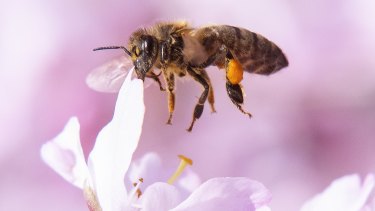Home » World News »
Doctors reportedly find four bees living in woman’s eye, feeding off her tears
The 29-year-old woman had no idea why her eye was swollen shut. She was in unbearable pain and could not stop tearing up. The Taiwanese woman said she was confused why what she thought was an infection kept getting worse, CTS News reported.
But when the woman, identified by her surname He, received treatment at Fooyin University Hospital in Taiwan, doctors didn't find a bacterial infection. While looking at He's eyes through a microscope, Hung Chi-ting, the hospital's head of ophthalmology, witnessed something he hadn't seen before.
Bees became trapped in the woman’s eye and fed off her tears.Credit:AP
Insect legs were wiggling from one of her eye sockets.
He yanked out a small bee, known as Halictidae or a "sweat bee". And it was alive.
The doctor, however, wasn't done. Soon he extracted a second sweat bee. And a third.
And, finally, a fourth bee was pulled from the woman's eyelid.
Craving salt, the bees had been feeding off He's tears, the doctor said at a news conference last week, later describing the odd medical diagnosis as a "world first". The insects had made a new home inside the woman's eyelid – that is, until they were all successfully removed alive.
"I saw something that looked like insect legs, so I pulled them out under a microscope slowly, and one at a time without damaging their bodies," Hung said, according to Business Insider Singapore.
So, how did sweat bees end up camping out inside a 29-year-old woman's eye? He suspects it all started the previous day. As He recounted in the news conference, she was taking part in the Qingming Festival, also known as Tomb Sweeping Day.
"I was visiting and tidying a relative's grave with my family," He recently told reporters. "I was squatting down and pulling out weeds."
As CTS News reported, He said she felt something get in her eye. Thinking it was only dirt, she cleaned her eye out with water and did not rub her eyes much for the rest of the day. She didn't think much of it until her eyes began to swell up that night and she experienced a stinging pain that made her tear up.
It would have been very likely for sweat bees to be around He at the time, Hung told reporters, as they tend to nest near graves and in the mountains.
At the hospital the following day, when Hung discovered that the sweat bees were feasting on He's tears, the doctor was relieved that the 29-year-old, who wore contacts, had not rubbed her eyes excessively when the pain worsened, Hung told the BBC. If she had, it could have worsened her inflamed cornea or potentially led to blindness.
Matan Shelomi, an associate professor of entomology at National Taiwan University, said he had never heard of sweat bees infesting a person before the recent incident.
"To my knowledge, this is the first case of a bee or a wasp getting caught in a part of a person's anatomy, as far as I know," he said. "I'm sure the sweat bees got by the eye and got squished between the eye and eyelid. They were in the wrong place at the wrong time."
In addition to needing pollen and nectar like other bees, Shelomi said, sweat bees, which are dark-coloured and metallic, will occasionally need salt to supplement their diet. A study this month from the Kansas Entomological Society found that sweat bees also look to tears as a protein source.
"They don't seem to be bothered by people, so they will go to any source of salt," Shelomi said. "I think they're kind of dumb if they come to humans for their salt. They haven't figured out what we are."
While there are more than 1,000 species of sweat bees in the United States, Canada and Central America, according to Terminix, they are almost painless, and only sting when they are provoked. On the Schmidt Sting Pain Index, a scale of relative agony caused by sawflies, wasps, bees and ants, the sweat bee comes in at the lowest level of pain. Described by the index as "light, ephemeral, almost fruity", the puny sting is compared to "a tiny spark [that] has singed a single hair on your arm".
"She couldn't have asked for a better bee to sting her in her eye," Shelomi said.
He was discharged and is expected to make a full recovery, KRON-TV reported. The bees are also still alive, Hung told the BBC, and will now be studied.
"This is the first time in Taiwan we've seen something like this," the doctor said.
Even though the case is probably the most unusual he's heard about in his time studying entomology, Shelomi emphasised that what happened at the gravesite in Taiwan was a fascinating but not worrisome "freak occurrence".
Washington Post
Source: Read Full Article



